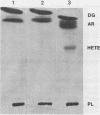Abstract
The mechanism of activation of intestinal guanylate cyclase by Escherichia coli heat-stable enterotoxin (STa) has been studied by using isolated rat intestinal epithelial cells and purified brush border membrane (BBM) preparations. Inhibitors of prostaglandin biosynthesis, quinacrine and 5,8,11,14-eicosatetraynoic acid (ETYA), significantly reduced intracellular levels of cyclic guanosine 3', 5'-monophosphate in isolated cells treated with STa. Although these data suggested that activation of phospholipase A2 and metabolism of arachidonic acid are involved in the mechanism of action of STa, other data ruled out such a mechanism. (i) The rate of release of [3H]arachidonic acid by prelabeled intestinal cells incubated with STa was the same as control cells not treated with STa. (ii) Thin-layer chromatography of lipid extracts of intestinal cells treated with STa and untreated cells did not reveal any quantitative or qualitative differences in free fatty acids, neutral lipids, and phospholipids. (iii) Amounts of prostaglandin PGE2, prostaglandin PGF2 alpha, and thromboxane B2 in intestinal cells and BBM incubated with STa did not increase compared with controls not incubated with STa. When purified BBM preparations were incubated with phospholipase A2 inhibitors (p-bromophenacyl bromide and quinacrine) or cyclooxygenase inhibitors (ETYA and indomethacin), basal and STa-induced guanylate cyclase activities were significantly reduced. Inhibitors of calcium-calmodulin-mediated reactions (EGTA [ethylene glycol-bis(beta-aminoethyl ether)-N,N-tetraacetic acid], trifluoperazine, and chlorpromazine) and calcium channel blockers (verapamil and nifedipine) also nonspecifically inhibited both basal and STa-stimulated guanylate cyclase in BBM preparations. Lanthanum, a competitive inhibitor of membrane-bound calcium, did not affect either basal or STa-stimulated guanylate cyclase of BBM preparations.(ABSTRACT TRUNCATED AT 250 WORDS)
Full text
PDF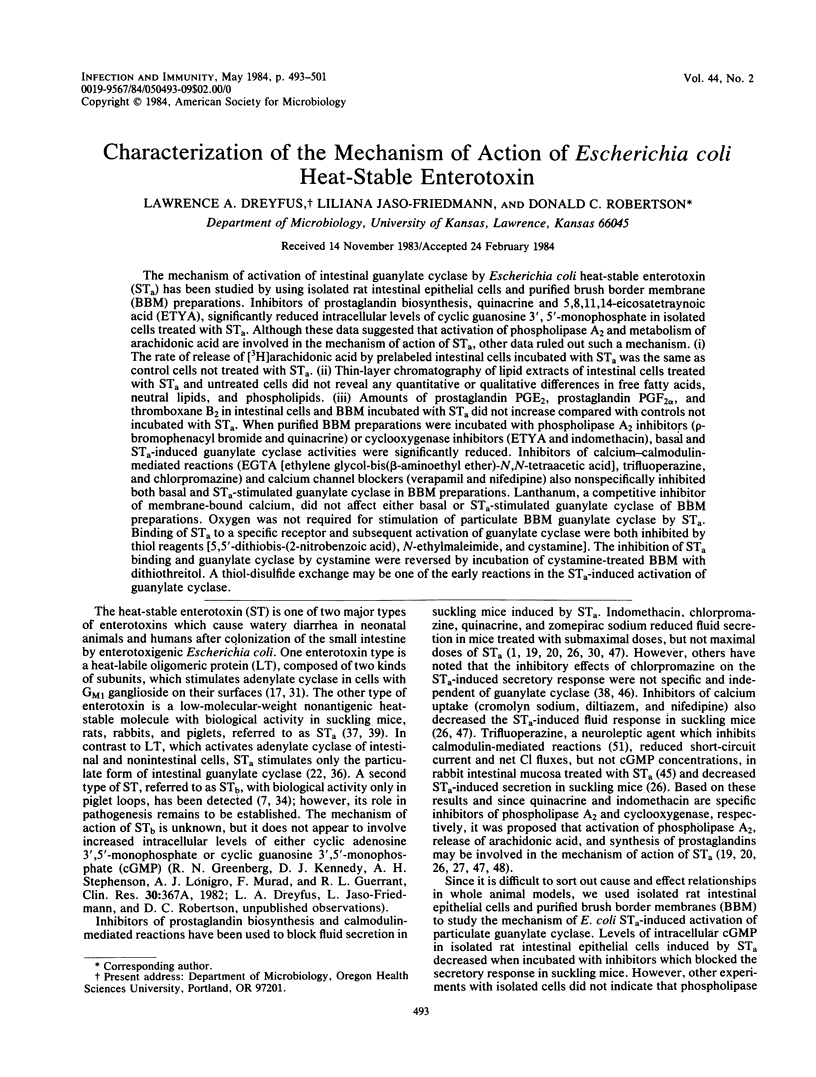
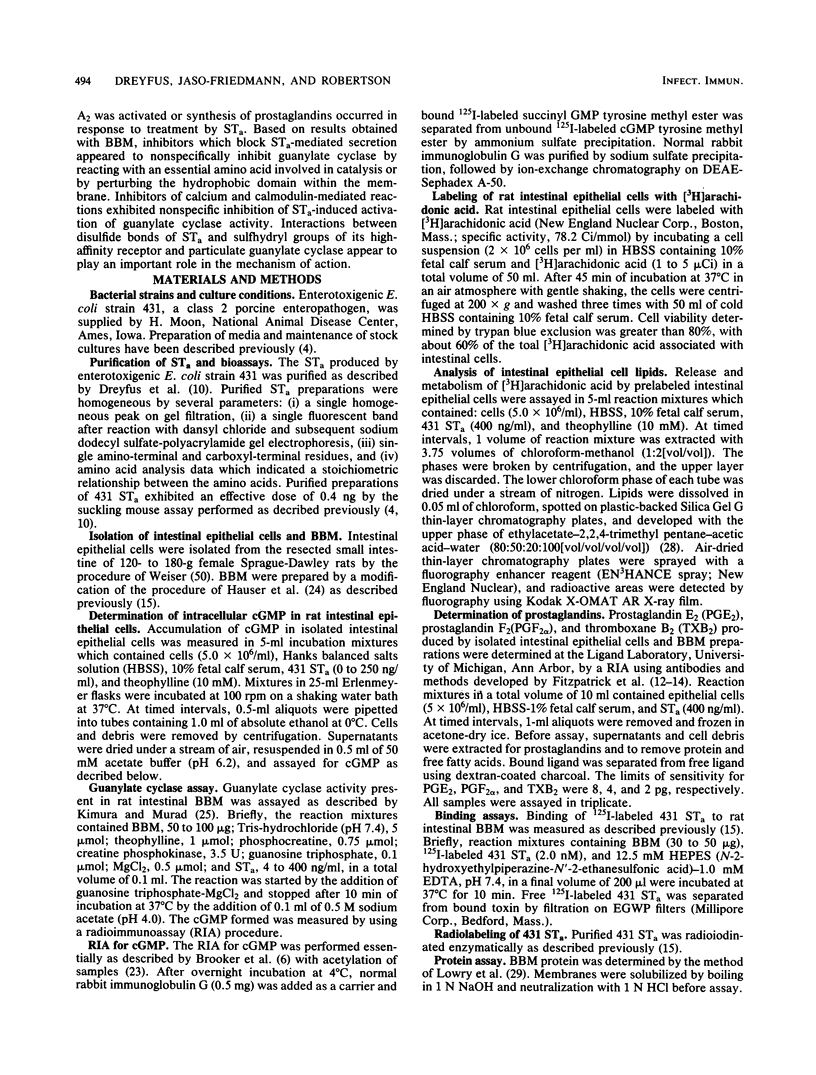
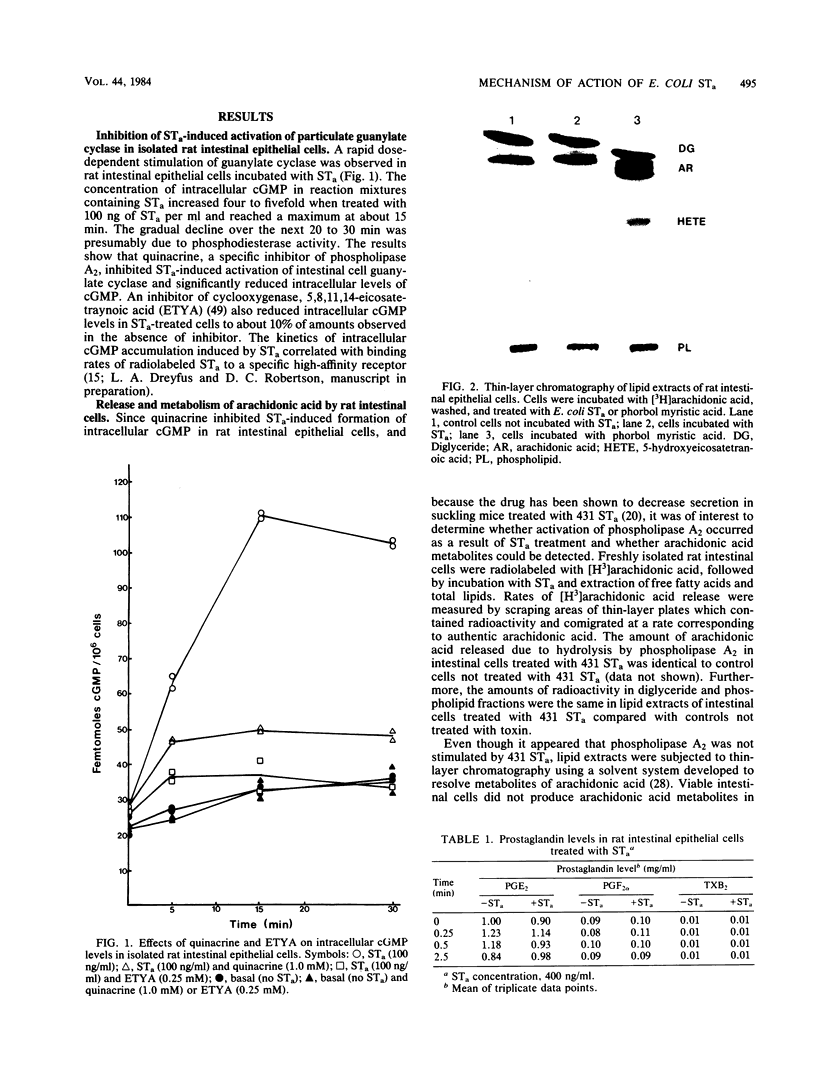
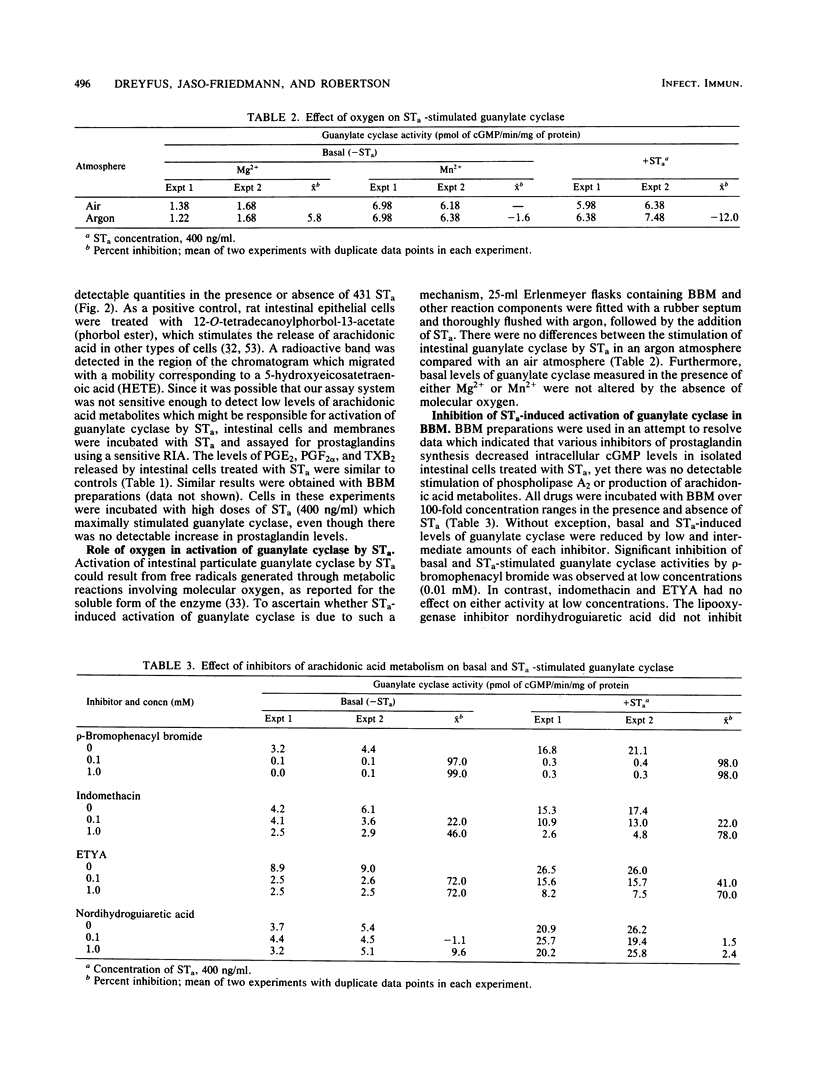
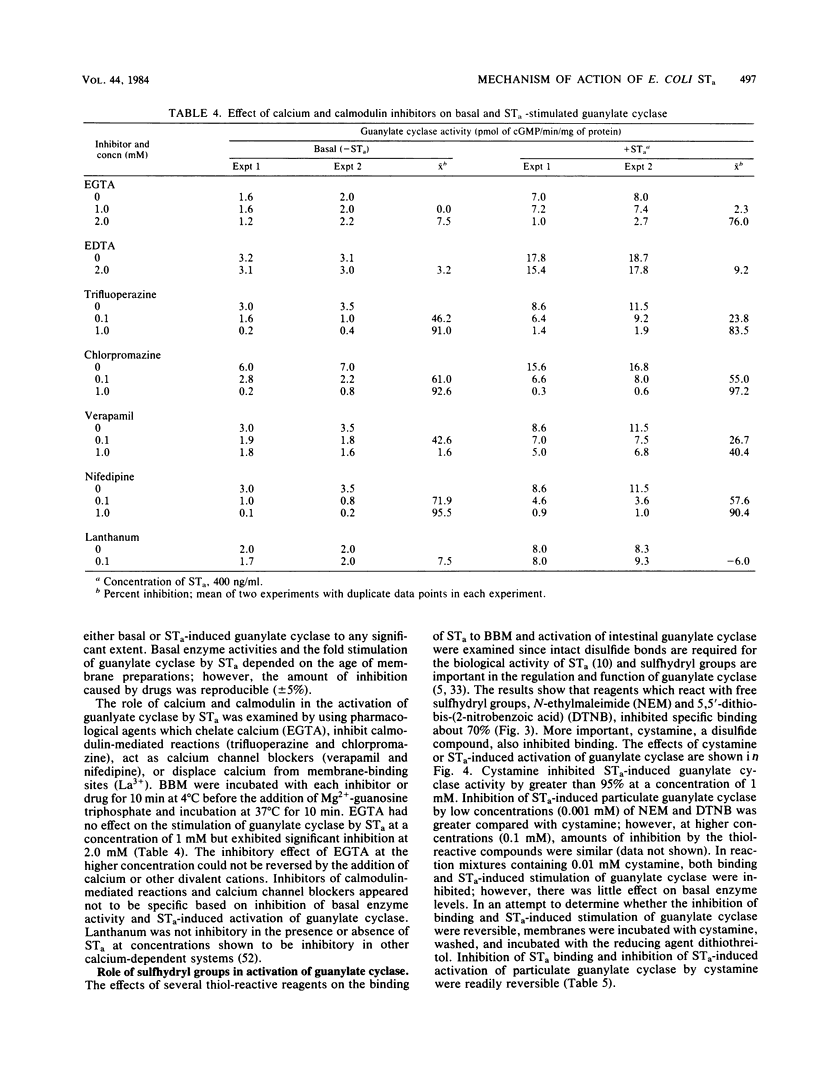
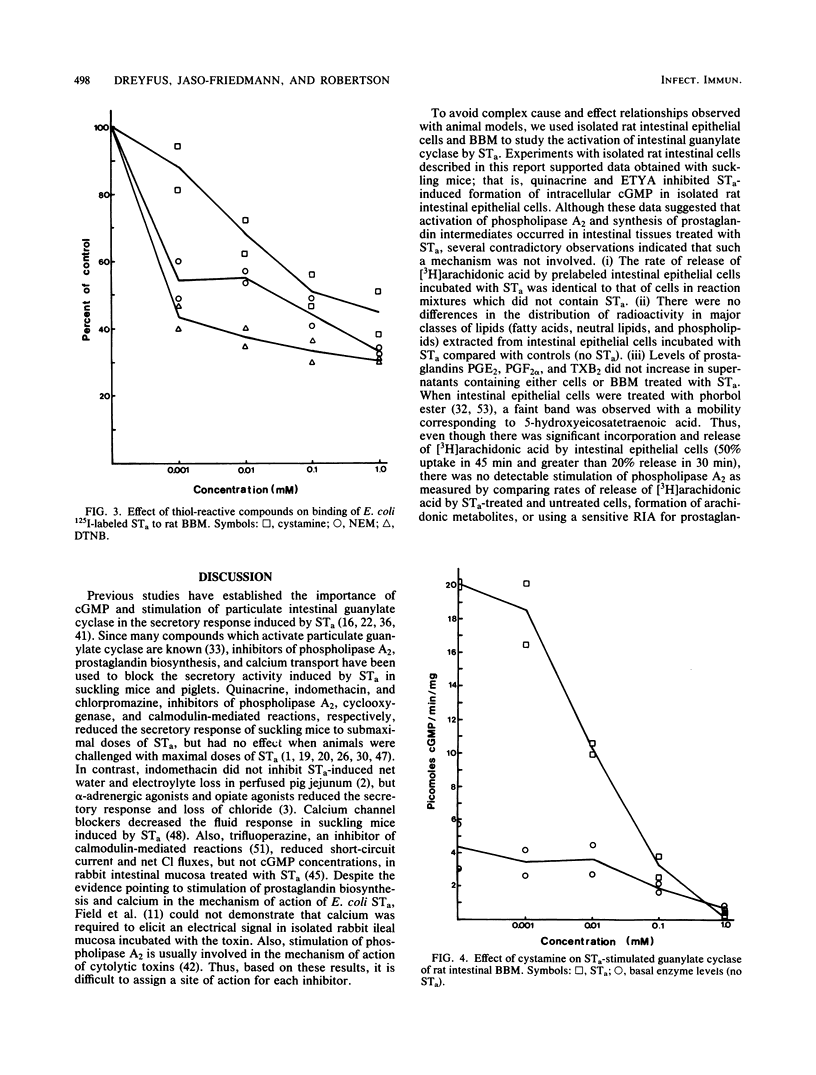
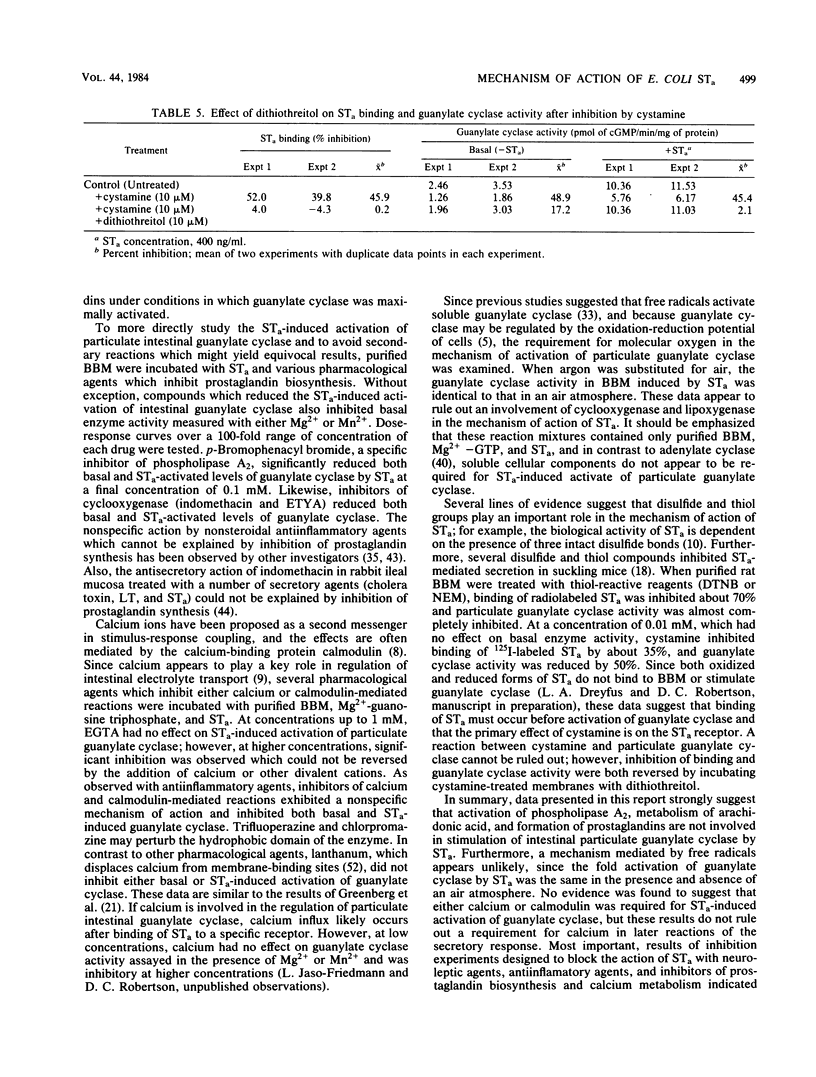
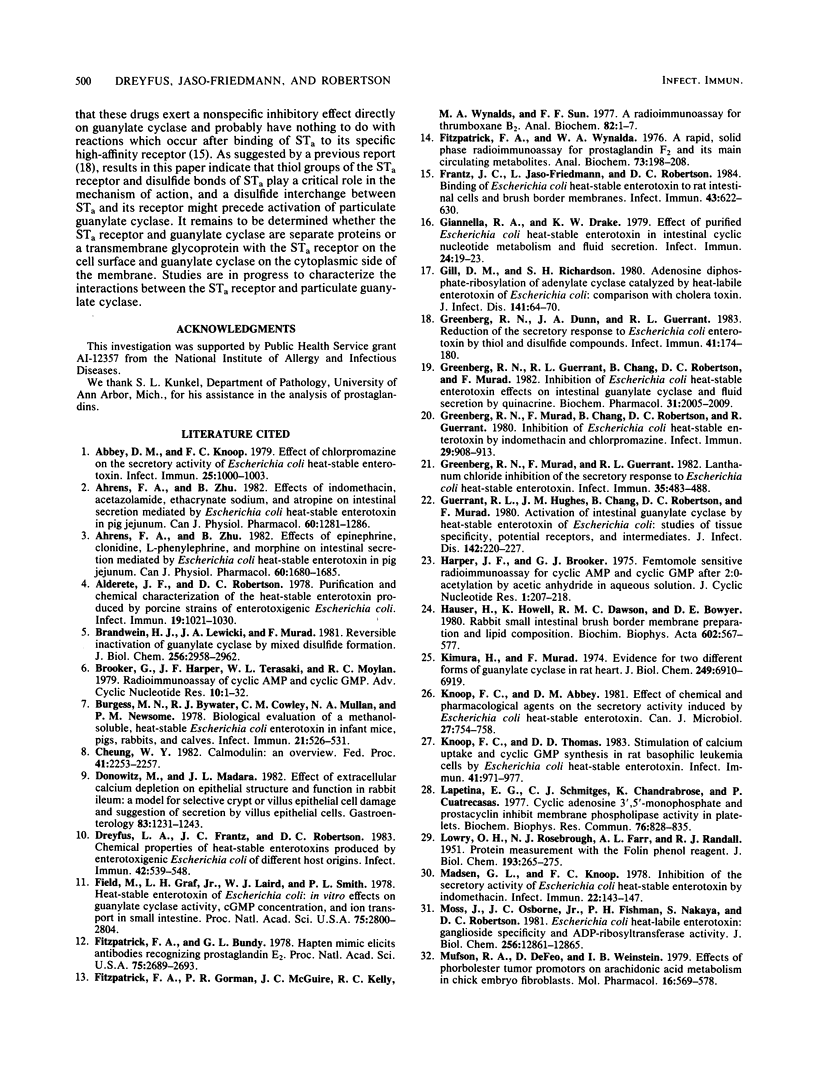
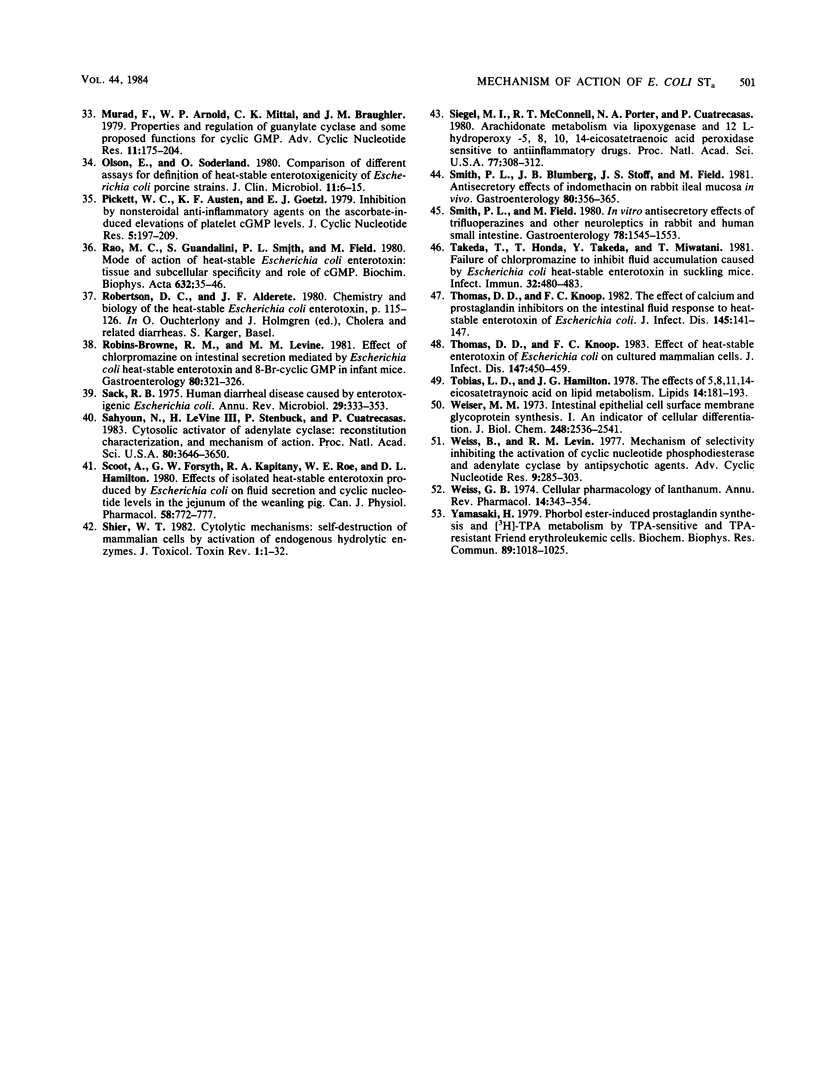
Images in this article
Selected References
These references are in PubMed. This may not be the complete list of references from this article.
- Abbey D. M., Knoop F. C. Effect of chlorpromazine on the secretory activity of Escherichia coli heat-stable enterotoxin. Infect Immun. 1979 Dec;26(3):1000–1003. doi: 10.1128/iai.26.3.1000-1003.1979. [DOI] [PMC free article] [PubMed] [Google Scholar]
- Ahrens F. A., Zhu B. L. Effects of epinephrine, clonidine, L-phenylephrine, and morphine on intestinal secretion mediated by Escherichia coli heat-stable enterotoxin in pig jejunum. Can J Physiol Pharmacol. 1982 Dec;60(12):1680–1685. doi: 10.1139/y82-246. [DOI] [PubMed] [Google Scholar]
- Ahrens F. A., Zhu B. Effects of indomethacin, acetazolamide, ethacrynate sodium, and atropine on intestinal secretion mediated by Escherichia coli heat-stable enterotoxin in pig jejunum. Can J Physiol Pharmacol. 1982 Oct;60(10):1281–1286. doi: 10.1139/y82-188. [DOI] [PubMed] [Google Scholar]
- Alderete J. F., Robertson D. C. Purification and chemical characterization of the heat-stable enterotoxin produced by porcine strains of enterotoxigenic Escherichia coli. Infect Immun. 1978 Mar;19(3):1021–1030. doi: 10.1128/iai.19.3.1021-1030.1978. [DOI] [PMC free article] [PubMed] [Google Scholar]
- Brandwein H. J., Lewicki J. A., Murad F. Reversible inactivation of guanylate cyclase by mixed disulfide formation. J Biol Chem. 1981 Mar 25;256(6):2958–2962. [PubMed] [Google Scholar]
- Brooker G., Harper J. F., Terasaki W. L., Moylan R. D. Radioimmunoassay of cyclic AMP and cyclic GMP. Adv Cyclic Nucleotide Res. 1979;10:1–33. [PubMed] [Google Scholar]
- Burgess M. N., Bywater R. J., Cowley C. M., Mullan N. A., Newsome P. M. Biological evaluation of a methanol-soluble, heat-stable Escherichia coli enterotoxin in infant mice, pigs, rabbits, and calves. Infect Immun. 1978 Aug;21(2):526–531. doi: 10.1128/iai.21.2.526-531.1978. [DOI] [PMC free article] [PubMed] [Google Scholar]
- Cheung W. Y. Calmodulin: an overview. Fed Proc. 1982 May;41(7):2253–2257. [PubMed] [Google Scholar]
- Donowitz M., Madara J. L. Effect of extracellular calcium depletion on epithelial structure and function in rabbit ileum: a model for selective crypt or villus epithelial cell damage and suggestion of secretion by villus epithelial cells. Gastroenterology. 1982 Dec;83(6):1231–1243. [PubMed] [Google Scholar]
- Dreyfus L. A., Frantz J. C., Robertson D. C. Chemical properties of heat-stable enterotoxins produced by enterotoxigenic Escherichia coli of different host origins. Infect Immun. 1983 Nov;42(2):539–548. doi: 10.1128/iai.42.2.539-548.1983. [DOI] [PMC free article] [PubMed] [Google Scholar]
- Field M., Graf L. H., Jr, Laird W. J., Smith P. L. Heat-stable enterotoxin of Escherichia coli: in vitro effects on guanylate cyclase activity, cyclic GMP concentration, and ion transport in small intestine. Proc Natl Acad Sci U S A. 1978 Jun;75(6):2800–2804. doi: 10.1073/pnas.75.6.2800. [DOI] [PMC free article] [PubMed] [Google Scholar]
- Fitzpatrick F. A., Bundy G. L. Hapten mimic elicits antibodies recognizing prostaglandin E2. Proc Natl Acad Sci U S A. 1978 Jun;75(6):2689–2693. doi: 10.1073/pnas.75.6.2689. [DOI] [PMC free article] [PubMed] [Google Scholar]
- Fitzpatrick F. A., Gorman R. R., Mc Guire J. C., Kelly R. C., Wynalda M. A., Sun F. F. A radioimmunoassay for thromboxane B2. Anal Biochem. 1977 Sep;82(1):1–7. doi: 10.1016/0003-2697(77)90127-0. [DOI] [PubMed] [Google Scholar]
- Fitzpatrick F. A., Wynalda M. A. A rapid, solid phase radioimmunoassay for prostaglandin F2alpha and its main circulating metabolite. Anal Biochem. 1976 May 21;73(1):198–208. doi: 10.1016/0003-2697(76)90155-x. [DOI] [PubMed] [Google Scholar]
- Frantz J. C., Jaso-Friedman L., Robertson D. C. Binding of Escherichia coli heat-stable enterotoxin to rat intestinal cells and brush border membranes. Infect Immun. 1984 Feb;43(2):622–630. doi: 10.1128/iai.43.2.622-630.1984. [DOI] [PMC free article] [PubMed] [Google Scholar]
- Giannella R. A., Drake K. W. Effect of purified Escherichia coli heat-stable enterotoxin on intestinal cyclic nucleotide metabolism and fluid secretion. Infect Immun. 1979 Apr;24(1):19–23. doi: 10.1128/iai.24.1.19-23.1979. [DOI] [PMC free article] [PubMed] [Google Scholar]
- Gill D. M., Richardson S. H. Adenosine diphosphate-ribosylation of adenylate cyclase catalyzed by heat-labile enterotoxin of Escherichia coli: comparison with cholera toxin. J Infect Dis. 1980 Jan;141(1):64–70. doi: 10.1093/infdis/141.1.64. [DOI] [PubMed] [Google Scholar]
- Greenberg R. N., Dunn J. A., Guerrant R. L. Reduction of the secretory response to Escherichia coli heat-stable enterotoxin by thiol and disulfide compounds. Infect Immun. 1983 Jul;41(1):174–180. doi: 10.1128/iai.41.1.174-180.1983. [DOI] [PMC free article] [PubMed] [Google Scholar]
- Greenberg R. N., Guerrant R. L., Chang B., Robertson D. C., Murad F. Inhibition of Escherichia coli heat-stable enterotoxin effects on intestinal guanylate cyclase and fluid secretion by quinacrine. Biochem Pharmacol. 1982 Jun 1;31(11):2005–2009. doi: 10.1016/0006-2952(82)90413-0. [DOI] [PubMed] [Google Scholar]
- Greenberg R. N., Murad F., Chang B., Robertson D. C., Guerrant R. L. Inhibition of Escherichia coli heat-stable enterotoxin by indomethacin and chlorpromazine. Infect Immun. 1980 Sep;29(3):908–913. doi: 10.1128/iai.29.3.908-913.1980. [DOI] [PMC free article] [PubMed] [Google Scholar]
- Greenberg R. N., Murad F., Guerrant R. L. Lanthanum chloride inhibition of the secretory response to Escherichia coli heat-stable enterotoxin. Infect Immun. 1982 Feb;35(2):483–488. doi: 10.1128/iai.35.2.483-488.1982. [DOI] [PMC free article] [PubMed] [Google Scholar]
- Guerrant R. L., Hughes J. M., Chang B., Robertson D. C., Murad F. Activation of intestinal guanylate cyclase by heat-stable enterotoxin of Escherichia coli: studies of tissue specificity, potential receptors, and intermediates. J Infect Dis. 1980 Aug;142(2):220–228. doi: 10.1093/infdis/142.2.220. [DOI] [PubMed] [Google Scholar]
- Harper J. F., Brooker G. Femtomole sensitive radioimmunoassay for cyclic AMP and cyclic GMP after 2'0 acetylation by acetic anhydride in aqueous solution. J Cyclic Nucleotide Res. 1975;1(4):207–218. [PubMed] [Google Scholar]
- Hauser H., Howell K., Dawson R. M., Bowyer D. E. Rabbit small intestinal brush border membrane preparation and lipid composition. Biochim Biophys Acta. 1980 Nov 18;602(3):567–577. doi: 10.1016/0005-2736(80)90335-1. [DOI] [PubMed] [Google Scholar]
- Kimura H., Murad F. Evidence for two different forms of guanylate cyclase in rat heart. J Biol Chem. 1974 Nov 10;249(21):6910–6916. [PubMed] [Google Scholar]
- Knoop F. C., Abbey D. M. Effect of chemical and pharmacological agents on the secretory activity induced by Escherichia coli heat-stable enterotoxin. Can J Microbiol. 1981 Aug;27(8):754–758. doi: 10.1139/m81-117. [DOI] [PubMed] [Google Scholar]
- Knoop F. C., Thomas D. D. Stimulation of calcium uptake and cyclic GMP synthesis in rat basophilic leukemia cells by Escherichia coli heat-stable enterotoxin. Infect Immun. 1983 Sep;41(3):971–977. doi: 10.1128/iai.41.3.971-977.1983. [DOI] [PMC free article] [PubMed] [Google Scholar]
- LOWRY O. H., ROSEBROUGH N. J., FARR A. L., RANDALL R. J. Protein measurement with the Folin phenol reagent. J Biol Chem. 1951 Nov;193(1):265–275. [PubMed] [Google Scholar]
- Lapetina E. G., Schmitges C. J., Chandrabose K., Cuatrecases P. Cyclic adenosine 3',5'-monophosphate and prostacyclin inhibit membrane phospholipase activity in platelets. Biochem Biophys Res Commun. 1977 Jun 6;76(3):828–835. doi: 10.1016/0006-291x(77)91575-3. [DOI] [PubMed] [Google Scholar]
- Madsen G. L., Knoop F. C. Inhibition of the secretory activity of Escherichia coli heat-stable enterotoxin by indomethacin. Infect Immun. 1978 Oct;22(1):143–147. doi: 10.1128/iai.22.1.143-147.1978. [DOI] [PMC free article] [PubMed] [Google Scholar]
- Moss J., Osborne J. C., Jr, Fishman P. H., Nakaya S., Robertson D. C. Escherichia coli heat-labile enterotoxin. Ganglioside specificity and ADP-ribosyltransferase activity. J Biol Chem. 1981 Dec 25;256(24):12861–12865. [PubMed] [Google Scholar]
- Mufson R. A., DeFeo D., Weinstein I. B. Effects of phorbol ester tumor promoters on arachidonic acid metabolism in chick embryo fibroblasts. Mol Pharmacol. 1979 Sep;16(2):569–578. [PubMed] [Google Scholar]
- Murad F., Arnold W. P., Mittal C. K., Braughler J. M. Properties and regulation of guanylate cyclase and some proposed functions for cyclic GMP. Adv Cyclic Nucleotide Res. 1979;11:175–204. [PubMed] [Google Scholar]
- Olsson E., Söderlind O. Comparison of different assays for definition of heat-stable enterotoxigenicity of Escherichia coli porcine strains. J Clin Microbiol. 1980 Jan;11(1):6–15. doi: 10.1128/jcm.11.1.6-15.1980. [DOI] [PMC free article] [PubMed] [Google Scholar]
- Pickett W. C., Austen K. F., Goetzl E. J. Inhibition by non-steroidal anti-inflammatory agents of the ascorbate-induced elevations of platelet cyclic AMP levels. J Cyclic Nucleotide Res. 1979;5(3):197–209. [PubMed] [Google Scholar]
- Rao M. C., Guandalini S., Smith P. L., Field M. Mode of action of heat-stable Escherichia coli enterotoxin. Tissue and subcellular specificities and role of cyclic GMP. Biochim Biophys Acta. 1980 Sep 17;632(1):35–46. doi: 10.1016/0304-4165(80)90247-0. [DOI] [PubMed] [Google Scholar]
- Robins-Browne R. M., Levine M. M. Effect of chlorpromazine on intestinal secretion mediated by Escherichia coli heat-stable enterotoxin and 8-Br-cyclic GMP in infant mice. Gastroenterology. 1981 Feb;80(2):321–326. [PubMed] [Google Scholar]
- Sack R. B. Human diarrheal disease caused by enterotoxigenic Escherichia coli. Annu Rev Microbiol. 1975;29:333–353. doi: 10.1146/annurev.mi.29.100175.002001. [DOI] [PubMed] [Google Scholar]
- Sahyoun N., LeVine H., 3rd, Stenbuck P., Cuatrecasas P. Cytosolic activator of adenylate cyclase: Reconstitution, characterization, and mechanism of action. Proc Natl Acad Sci U S A. 1983 Jun;80(12):3646–3650. doi: 10.1073/pnas.80.12.3646. [DOI] [PMC free article] [PubMed] [Google Scholar]
- Siegel M. I., McConnell R. T., Porter N. A., Cuatrecasas P. Arachidonate metabolism via lipoxygenase and 12L-hydroperoxy-5,8,10,14-icosatetraenoic acid peroxidase sensitive to anti-inflammatory drugs. Proc Natl Acad Sci U S A. 1980 Jan;77(1):308–312. doi: 10.1073/pnas.77.1.308. [DOI] [PMC free article] [PubMed] [Google Scholar]
- Smith P. L., Blumberg J. B., Stoff J. S., Field M. Antisecretory effects of indomethacin on rabbit ileal mucosa in vitro. Gastroenterology. 1981 Feb;80(2):356–365. [PubMed] [Google Scholar]
- Smith P. L., Field M. In vitro antisecretory effects of trifluoperazine and other neuroleptics in rabbit and human small intestine. Gastroenterology. 1980 Jun;78(6):1545–1553. [PubMed] [Google Scholar]
- Takeda T., Honda T., Takeda Y., Miwatani T. Failure of chlorpromazine to inhibit fluid accumulation caused by Escherichia coli heat-stable enterotoxin in suckling mice. Infect Immun. 1981 May;32(2):480–483. doi: 10.1128/iai.32.2.480-483.1981. [DOI] [PMC free article] [PubMed] [Google Scholar]
- Thomas D. D., Knoop F. C. Effect of heat-stable enterotoxin of Escherichia coli on cultured mammalian cells. J Infect Dis. 1983 Mar;147(3):450–459. doi: 10.1093/infdis/147.3.450. [DOI] [PubMed] [Google Scholar]
- Thomas D. D., Knoop F. C. The effect of calcium and prostaglandin inhibitors on the intestinal fluid response to heat-stable enterotoxin of Escherichia coli. J Infect Dis. 1982 Feb;145(2):141–147. doi: 10.1093/infdis/145.2.141. [DOI] [PubMed] [Google Scholar]
- Tobias L. D., Hamilton J. G. The effect of 5,8,11,14-eicosatetraynoic acid on lipid metabolism. Lipids. 1979 Feb;14(2):181–193. doi: 10.1007/BF02533870. [DOI] [PubMed] [Google Scholar]
- Weiser M. M. Intestinal epithelial cell surface membrane glycoprotein synthesis. I. An indicator of cellular differentiation. J Biol Chem. 1973 Apr 10;248(7):2536–2541. [PubMed] [Google Scholar]
- Weiss B., Levin R. M. Mechanism for selectively inhibiting the activation of cyclic nucleotide phosphodiesterase and adenylate cyclase by antipsychotic agents. Adv Cyclic Nucleotide Res. 1978;9:285–303. [PubMed] [Google Scholar]
- Yamasaki H., Mufson R. A., Weinstein I. B. Phorbol ester induced prostaglandin synthesis and [3H]-TPA metabolism by TPA-sensitive and TPA-resistant Friend erythroleukemia cells. Biochem Biophys Res Commun. 1979 Aug 13;89(3):1018–1025. doi: 10.1016/0006-291x(79)91878-3. [DOI] [PubMed] [Google Scholar]



